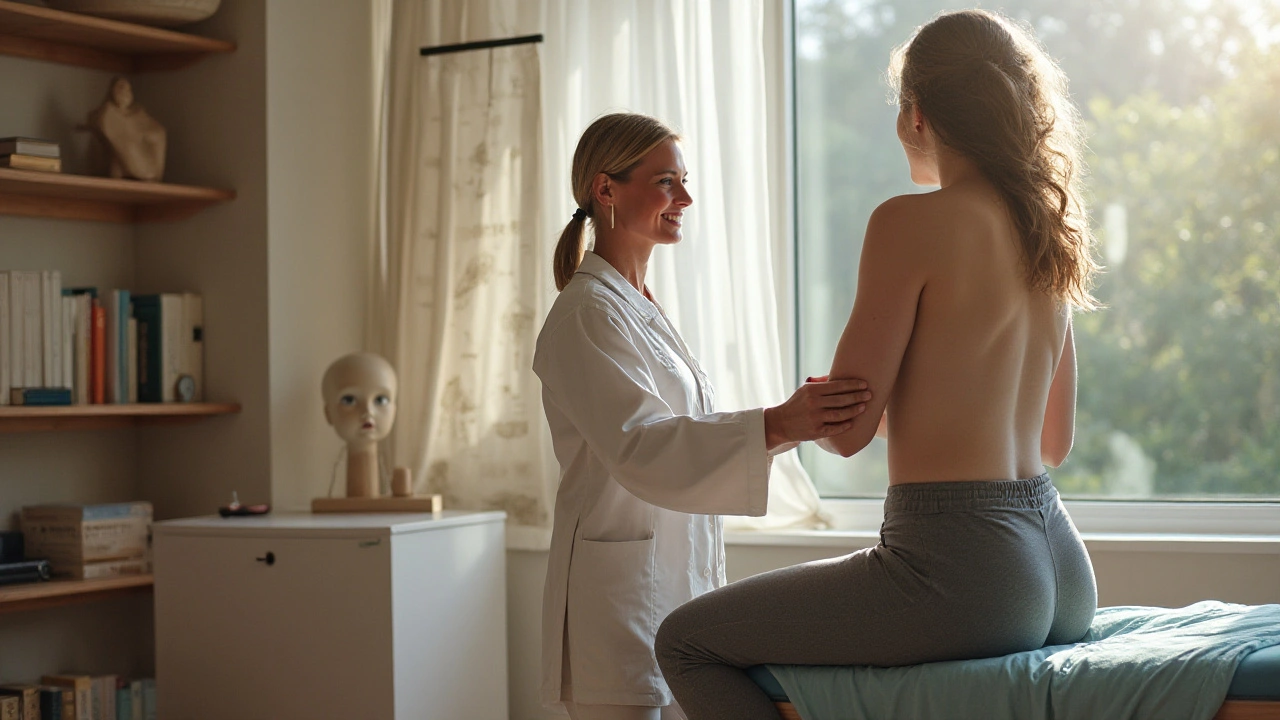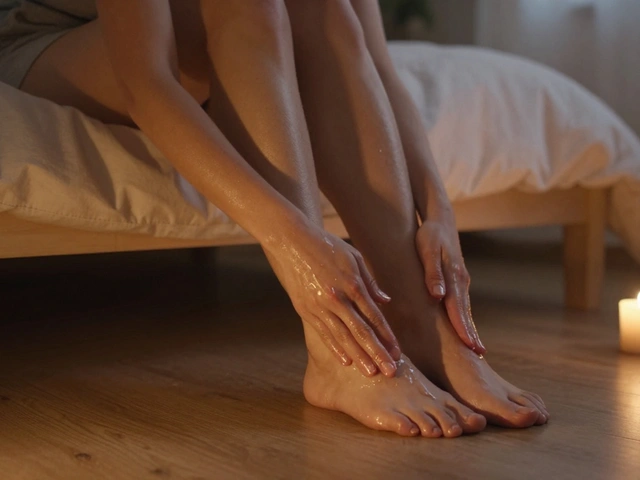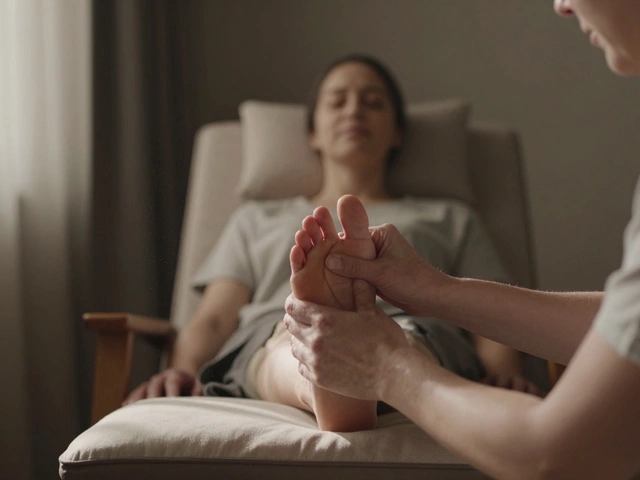Ortho-Bionomy is not just another therapy; it's a blend of art and science aimed at restoring your body’s balance. Developed by Arthur Lincoln Pauls in the 1970s, this gentle, non-invasive approach leverages the body's self-correcting abilities.
The practice is grounded in osteopathic techniques and martial arts philosophy. It aims to treat pain and discomfort through subtle yet effective movements. Think of Ortho-Bionomy as a conversation between you and your body, guiding it back to harmony.
- Understanding Ortho-Bionomy
- History and Origins
- Key Principles
- Techniques and Methods
- Benefits of Ortho-Bionomy
- Practical Tips for Practice
Understanding Ortho-Bionomy
Ortho-Bionomy is a unique therapeutic discipline designed to aid the body in healing itself. Originating from the osteopathic principles set forth by Arthur Lincoln Pauls, this practice focuses on using gentle movements and positions to encourage the body to correct itself. At its core, Ortho-Bionomy aims to relieve pain and promote well-being without imposing forceful adjustments.
The term Ortho-Bionomy combines the Greek words for 'correct' (ortho) and 'the laws of life' (bionomy), reflecting its foundation in natural principles and movement. Unlike many conventional therapies, Ortho-Bionomy centers on the idea that the body has an inherent ability to structure itself correctly when given the right cues. The therapist's role is more about guiding and supporting rather than fixing or realigning.
What sets Ortho-Bionomy apart from other body therapies is its emphasis on comfort and ease. Techniques are designed to be as non-invasive as possible, respecting the body's current state and limitations. This often involves using the body's preferred positions and movements to make subtle corrections. The practice can be likened to a dance where both the practitioner and receiver work in harmony to achieve balance and relief.
Ortho-Bionomy also incorporates concepts from martial arts, particularly Judo, which Dr. Pauls studied extensively. Principles such as using the body's momentum and balance extend seamlessly into this therapeutic approach. Practitioners apply these ideas to create movements that are fluid and natural, making it easier for the body to respond positively.
‘The body inherently knows what it needs to do to heal,’ Dr. Pauls once remarked.
The practice involves a variety of techniques, from gentle touch and positioning to movement re-education and postural alignment. Sessions are typically one-on-one and can last anywhere from 30 minutes to an hour, depending on the client's needs. A significant part of the therapy is also educational, encouraging clients to become more aware of their bodies and how they move. This increased self-awareness often translates into better posture and reduced pain in daily life.
One of the most appealing aspects of Ortho-Bionomy is its adaptability. Techniques can be tailored to suit a wide range of conditions and clients, from those with acute injuries to people dealing with chronic pain. It’s also highly beneficial for individuals looking to improve their overall sense of well-being. By focusing on gentle, corrective movements, Ortho-Bionomy can help alleviate pain and discomfort without the need for invasive procedures or medications.
Scientific studies and anecdotal evidence suggest that Ortho-Bionomy is effective in treating a variety of conditions, including back pain, headaches, and stress-related symptoms. Its holistic approach not only addresses physical discomfort but also promotes emotional and mental well-being. This makes it a comprehensive solution for those seeking both short-term relief and long-term health benefits.
History and Origins
The story of Ortho-Bionomy begins in the early 1970s with Arthur Lincoln Pauls, an osteopath and judo instructor. Arthur was intrigued by the body's innate ability to heal itself and sought to create a method that harnessed this power. He was influenced by osteopathic principles and his learnings from martial arts, combining them into a unique form of therapy.
Arthur’s approach was different from traditional manipulative therapies. He observed that gentle and small adjustments were often more effective than forceful manipulations. Ortho-Bionomy was born from this understanding, placing a significant emphasis on comfort and ease during treatment. The technique focuses on positioning the body in ways that prompt natural self-correction.
The fusion of Western science with Eastern philosophy made Ortho-Bionomy distinct. Unlike many invasive techniques, it respects the body’s wisdom. The name Ortho-Bionomy itself comes from Greek, with “Ortho” meaning correct, “Bio” meaning life, and “Nomy” meaning law, essentially translating to ‘the correct application of the laws of life’.
Arthur’s students found remarkable results, and the practice began to spread. Today, Ortho-Bionomy is known globally and has a dedicated community of practitioners and patients. Its impact can be seen in various settings, from private practices to holistic wellness centers. Several healthcare professionals now include it in their treatment options, appreciating its gentle yet effective nature.
“Ortho-Bionomy is a respectful and effective approach to healing, focusing on the body’s inherent ability to correct itself,” says Dr. Michael Smith, a renowned osteopath, and educator.
Recent studies have shown its benefits in managing pain, improving posture, and enhancing overall well-being. According to a survey conducted in 2022, 87% of practitioners reported positive feedback from their clients. Such data supports the effectiveness and growing popularity of this therapy.
The development of Ortho-Bionomy is an ongoing process. As practitioners continue to explore and refine techniques, new insights emerge, enriching the method. While its core principles remain the same, the application of these principles evolves, adapting to individual needs and contemporary understanding of human physiology.

Key Principles
The therapy of Ortho-Bionomy revolves around a few key principles that distinguish it from other forms of body healing. One of its primary concepts is the idea of 'going with the body's flow' rather than forcing it into alignment. This principle comes from the belief that the body inherently knows how to heal itself and just needs gentle guidance.
The principle of 'position of ease' is central to Ortho-Bionomy. Here, practitioners find the most comfortable, least painful positions for the body parts in stress. This establishes a state of relaxation, prompting the body to self-correct. By moving through a range of gentle motions, the body recognizes dysfunctional patterns and adjusts accordingly.
Another cornerstone is the 'reflexive response'. Pain often results in reflexive muscle contractions, leading to imbalances. In Ortho-Bionomy, these reflexes are met with gentle counter-movements, encouraging the body to release tension. This process is akin to a dialogue where the practitioner listens to the body's feedback and responds appropriately.
Practitioners also focus on 'self-care and self-awareness'. Clients are taught to understand and respect their own body's needs. By fostering self-awareness, Ortho-Bionomy aims to empower individuals to take an active role in their own healing process. Imagine being in sync with your body's subtle signals, knowing precisely what it requires for optimal functioning.
Arthur Lincoln Pauls, the founder, emphasized 'non-force' methods. This gentle approach minimizes strain on the body, contrasting sharply with more aggressive therapies. Pauls believed that the body responds better to kindness than force. Over time, this becomes a transformative experience for those undergoing the therapy.
An additional key principle is 'energy efficiency'. The goal is to achieve the maximum therapeutic effect with minimal effort. This principle makes Ortho-Bionomy particularly appealing for individuals who may be sensitive to more invasive techniques.
Ortho-Bionomy also incorporates the principle of 'dynamic equilibrium'. The idea is that the body is always seeking balance, both internally and in relation to its environment. Through the practice, individuals learn to recognize and maintain this balance, which can lead to a greater sense of overall well-being.
Lastly, the principle of 'holistic health' is paramount. Ortho-Bionomy does not just focus on isolated symptoms but considers the whole person. It integrates physical, emotional, and even spiritual well-being. This holistic approach often leads to more sustainable, long-term outcomes.
Techniques and Methods
Ortho-Bionomy employs a variety of techniques and methods aimed at leveraging the body's self-correcting mechanisms. The approach is gentle, non-invasive, and prioritizes comfort and ease for the client. One of the primary techniques used in Ortho-Bionomy is called 'Positioning for Release.'
This technique involves positioning the body in such a way that it promotes relaxation and reduces tension. The practitioner will move the client into specific positions and hold them there, allowing the muscle and joint tension to release naturally. This method can be particularly effective in relieving chronic pain and discomfort.
Another core technique is 'Isometrics.' This involves the use of gentle resistance to engage the muscles without causing strain. The practitioner will guide the client through a series of movements, applying mild resistance to help the muscles realign themselves naturally. This technique is effective in improving muscle tone and flexibility.
'Reflexive Release' is another method used in Ortho-Bionomy, focusing on stimulating the body’s reflexes to encourage relaxation and healing. Practitioners apply light pressure to specific points on the body, triggering a reflexive response that promotes healing. This technique can be particularly effective for individuals dealing with stress and anxiety.
One of the unique aspects of Ortho-Bionomy is its emphasis on client involvement. Practitioners often incorporate 'Self-Care Techniques' into their sessions, teaching clients simple exercises and movements they can perform at home to maintain their well-being. This empowers clients to take an active role in their healing process.
According to a study published in the 'Journal of Bodywork and Movement Therapies,'
"Ortho-Bionomy techniques have been shown to significantly reduce pain and improve functional mobility in individuals with chronic conditions."
The efficacy of Ortho-Bionomy is not solely based on its physical techniques. The practice also incorporates 'Energetic Techniques,' which involve the subtle manipulation of the body's energy fields. Practitioners use their hands to feel and influence the flow of energy within the body, promoting a sense of balance and harmony.
Overall, the techniques and methods used in Ortho-Bionomy are designed to be adaptable and responsive to each individual’s unique needs. Whether you are dealing with chronic pain, stress, or emotional imbalances, these techniques can provide relief and promote overall well-being.

Benefits of Ortho-Bionomy
If you're exploring ways to enhance your well-being, Ortho-Bionomy offers a multitude of benefits. One of the most prominent advantages is pain relief. Whether it's chronic pain from long-term conditions or acute discomfort from recent injuries, this therapy has proven effective. It doesn't just mask the pain; it addresses the root causes. The gentle techniques promote the body's natural healing mechanisms. Many people have reported significant improvements after just a few sessions.
Another critical benefit is improved posture. In today's digital age, many of us suffer from poor posture due to prolonged sitting. Ortho-Bionomy helps realign the body, leading to better posture and less strain on muscles and joints. This realignment also aids in reducing tension headaches, neck pain, and even lower back issues. Many practitioners emphasize that this therapy fosters self-awareness, which can be life-changing.
If stress relief is what you are aiming for, then Ortho-Bionomy might be your answer. The subtle, mindful movements involved in the practice have a calming effect on the nervous system. It’s like giving your body and mind a mini-vacation. The therapy encourages deep relaxation, reducing stress hormones and promoting a sense of well-being. This relaxation can lead to better sleep, improved mood, and even enhanced focus and productivity during the day.
In the words of Arthur Lincoln Pauls, the founder of Ortho-Bionomy, 'The body has an inherent wisdom. We just need to listen.'
Ortho-Bionomy also complements other treatments effectively. Whether you're undergoing medical treatment or practicing other therapies, this gentle approach integrates seamlessly, enhancing the overall impact. It’s non-invasive, making it a safe option for almost everyone, including pregnant women and the elderly. For those interested in natural healing, Ortho-Bionomy aligns well with holistic health principles.
Moreover, this practice encourages self-care. Rather than relying solely on practitioners, clients learn techniques they can apply at home. This empowers individuals to take control of their health. Educating yourself on these techniques can be immensely empowering. You become more attuned to your body and can make adjustments to alleviate discomfort as it arises. This can lead to long-term improvements in your quality of life.
Pain relief, better posture, stress reduction, and enhanced overall well-being are just the tip of the iceberg. If you're curious about how Ortho-Bionomy can benefit you specifically, consider giving it a try. The science and art behind this practice offer a unique avenue for achieving a more balanced and healthier life.
Practical Tips for Practice
If you're considering incorporating Ortho-Bionomy into your routine, there are some practical tips to make the experience as beneficial as possible. First, find a reputable practitioner. Research and ask for recommendations from people who have had positive outcomes. A good practitioner can guide you through the techniques and help you understand the principles behind this body therapy.
Before your session, try to relax as much as you can. The more relaxed you are, the more effectively your body can respond to the treatment. Wear loose, comfortable clothing that allows freedom of movement. This will make it easier for the practitioner to work on different areas of your body without restriction.
During the session, pay close attention to your body's responses. Communication with your practitioner is key. Keep them informed about your comfort level and any sensations you experience. Remember, Ortho-Bionomy is about listening to your body and responding to its needs. Don't hesitate to speak up if something feels off.
Post-session, it's important to drink plenty of water. This helps flush out toxins that may have been released during the treatment. Light stretching or a gentle walk can help your body integrate the new changes. Avoid heavy lifting or strenuous activities immediately after a session to give your body time to adjust.
Consistency is crucial for long-term benefits. Consider scheduling regular sessions to maintain and improve your progress. Keep a journal to track how you feel after each session. This can help you notice patterns and better understand your body's healing process.
“Your body is your temple. Keep it pure and clean for the soul to reside in.” – B.K.S. Iyengar
You can also practice some Ortho-Bionomy techniques at home. Simple exercises focusing on gentle stretching and relaxation can be highly beneficial. Start with basic movements and gradually move to more complex techniques as you become more comfortable. Consider investing in instructional materials like books or videos to guide your practice at home.
Finally, combine Ortho-Bionomy with other forms of self-care for optimal results. Pairing it with practices like yoga, meditation, or even regular walking can enhance the overall benefits. The goal is to create a holistic approach to your well-being, focusing not just on the physical but also on the mental and emotional aspects of health.
By being mindful and attentive to your body's needs, you can make Ortho-Bionomy a powerful tool in your self-care routine. Embrace the journey towards pain relief and better health, and remember that small, consistent steps can lead to significant improvements over time.










